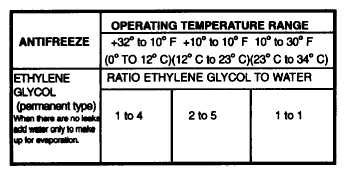| |
TM 10-3930-671-24
There are instances where this corrosive element has
eaten holes through cast iron parts such as water pump
impellers and bodies. This condition is caused by
electrolysis taking place in the parts involved. Where
these
conditions
exist,
water
filters
should
be
incorporated
in
the
assembly
to
remove
these
troublesome elements and off-set the electrolytic action.
EFFECT OF ALTITUDE ON COOLING
Water boils at 212°F (100°C) under atmospheric
pressure at sea level. This pressure becomes less at
higher altitudes and the reduced pressure causes water
and other liquids to boil at a lower temperature.
ANTI-FREEZES
Water freezes at 32°F (0°C), forming solid ice and
expanding
about
9%
in
volume-which
causes
tremendous pressure and serious damage when allowed
to freeze inside the cooling system. When operating
temperatures are below 32°F (0°C), an anti-freeze liquid
must be added which will lower the freezing point to a
safe margin below the anticipated temperature of outside
air. Permanent anti-freeze will also raise the boiling
temperature of the coolant. The correct proportion of
anti-freeze is also important when the engine is to be
operated under high ambient temperature conditions.
CORROSION INHIBITORS
Corrosion inhibitors can cause damage
to the eyes or skin. n contact is made,
immediately wash skin with water. For
the eyes, Immediately flush the eyes with
water for several minutes. In either
event, seek prompt medical attention.
Water forms rust due to its natural tendency to combine
chemically with iron and air in the system. Rust inhibitors
for water are inexpensive, simple to use and make
cleaning and flushing necessary only after long periods
of operation.
The addition of a corrosion inhibitor is not necessary if an
anti-freeze containing a rust inhibitor is used.
RADIATOR
The radiator or heat exchanger consists of a series of
metal tubes through which the coolant is circulated. In
standard radiator design fins are connected to the metal
tubes to give an extended surface through which heat
can be dissipated. It is important that these tubes be
kept clean on the inside and the fins free of dirt on the
outside so the maximum heat transfer can take place in
the radiator.
Blowing out between the fins of the radiator, using
compressed air, in a direction opposite to that of the fan
circulated air, will serve to keep the cooling surfaces of
the core free of dirt and other particles. Operating
conditions will determine the frequency of this service.
Every 500 hours of operation the radiator and cooling
system should be well cleaned and flushed with clean
water.
Radiator Coolant Inlet
Wherever possible, only soft clean water should be used
in the cooling system. Hard water will cause scale to
form in the radiator and the engine water jackets and
cause poor heat transfer. Where the use of hard water
cannot be avoided an approved water softener can be
used.
CLEANING COOLING SYSTEM
Deposits of sludge, scale and rust on the cooling
surfaces prevent normal heat transfer from the metal
surfaces to the coolant and, in time, render the cooling
F-146
|







